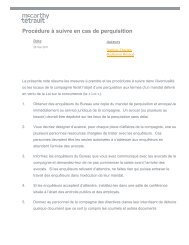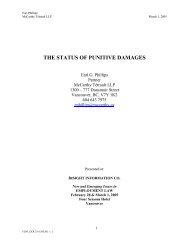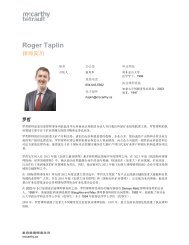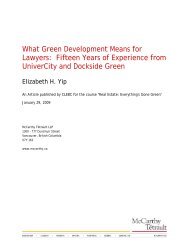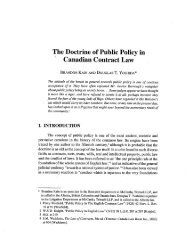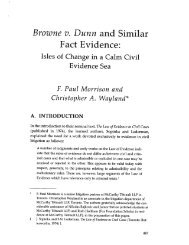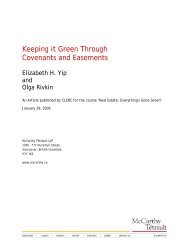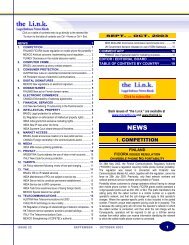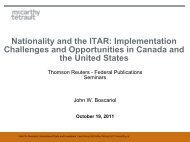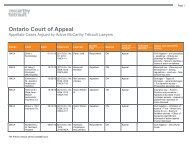Presentation Material - McCarthy Tétrault
Presentation Material - McCarthy Tétrault
Presentation Material - McCarthy Tétrault
You also want an ePaper? Increase the reach of your titles
YUMPU automatically turns print PDFs into web optimized ePapers that Google loves.
Chris Falk<br />
Stefanie Morand<br />
<strong>McCarthy</strong> Tétrault LLP<br />
Comment: Often practitioners are not contacted until months after the death of<br />
the taxpayer and it is not uncommon for the estate to have realized capital gains<br />
in the interim. The realization of gains is especially common in circumstances in<br />
which the assets of the estate include a portfolio of publicly-traded securities.<br />
Need for a Legislative Fix<br />
As noted above, given the text, context and purpose of subsections 40(3.6), 40(3.61) and<br />
164(6), it is the authors’ view that the provisions should be interpreted in a manner which does<br />
not give rise to the circularity issue identified in the Moraitis/Kakkar Article and commented on<br />
by the CRA at the 2012 STEP Round Table.<br />
If, however, contrary to what in the authors’ view is the better interpretation, the provisions are<br />
to be interpreted so as to give rise to the circularity issue due to a technical flaw in the drafting<br />
of subsection 40(3.61), a legislative fix is required so as not to frustrate the underlying purpose<br />
and policy of the provisions. To this end, the need for such a fix would be especially acute<br />
having regard to:<br />
• the widespread nature of the issue;<br />
• the impracticalities of requiring that the estate not realize any capital gains in its first<br />
taxation year;<br />
• the draconian consequences if even a nominal gain is realized;<br />
• the fact that the purpose of subsection 164(6) planning is to relieve against double<br />
taxation; and<br />
• the recent positions of the CRA taking a relatively narrow view as to the availability of<br />
pipeline planning.<br />
In any event, assuming that the authors are correct in their interpretation of the provisions (i.e.,<br />
assuming that the Alternative Reading governs such that the circularity issue does not arise), a<br />
legislative fix might nonetheless be appropriate in respect of two related issues – namely:<br />
• whether the entire gross capital loss should be available for carry-back rather than just<br />
the net amount (i.e., $450,000 rather $449,999 in the example set out above); and<br />
• whether subsection 40(3.61) should be extended to apply to subsection 70(6) spouse<br />
trusts, alter ego trusts and joint spousal or common-law partner trusts as recommended<br />
by the CBA-CICA Joint Committee on Taxation in February 2005. 65<br />
Practical Advice Regarding Subsection 164(6) in Light of CRA’s Position<br />
While the CRA’s position in respect of subsections 40(3.6), 40(3.61) and 164(4) remains<br />
uncertain, the 2012 STEP Conference response has placed tax practitioners on notice that the<br />
65<br />
See also question 8 of the 2012 British Columbia Tax Conference CRA Round Table where the CRA was asked<br />
whether it had any comments or further information to add in respect of the Committee’s submission.<br />
560600/422632<br />
MT DOCS 11864055v1G<br />
25



